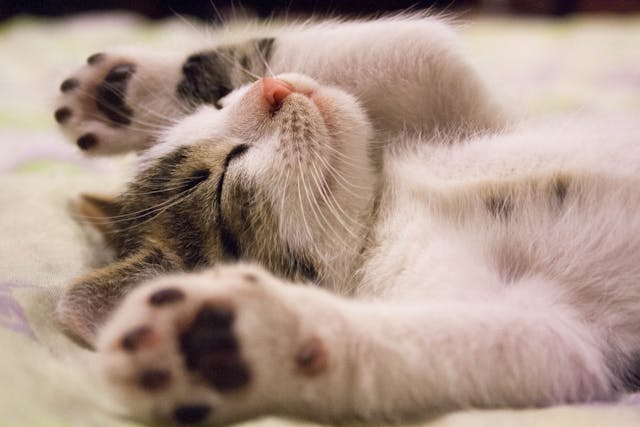
How do cats land on their feet? Cats land on their feet because they have an inbuilt mechanism called the “righting reflex”, which very quickly tells them which direction they are pointing in and to reorient themselves.
Cats are famous for always landing on their feet. We all know that a cat dropped from almost any height will twist itself round in mid air so that it lands with its feet down. In fact, this reaction is so fast and so perfect, that cats only need a distance of about 30 cm to be able to twist themselves feet down. If you drop your cat any lower than that, it is probably going to land on its side. So, how do cats do this?
There are several things that work in conjunction here. The first is the cat’s vestibular apparatus. We have looked at this before. It is the balance system in the inner ear and it is how we are able to move and balance. When the vestibular system is combined with the vision system, it is the reason why you can move a chicken and its head stays perfectly still. And it is the reason why you can twist your head to the left or right and your eyes will stay focused on these words. A cat’s vestibular system tell it which way is up and which way is down. Another thing that allows the to flip over in the air, and is one of the main reasons why we can’t, is how flexible they are. Their spines bend to a great extent and their limbs are attached to their bodies by free-floating joints, rather than the stiff bone joints that we have. This allows them to fold and twist much more than we can.
When you drop a cat on its back, the vestibular system will coordinate with the visual system and send a very quick signal to say that the cat is the wrong way up. This initiates a very quick reaction. The first step is to bend in the middle so that their front half and rear half point in different directions. Doing this lets them move both halves of their body separately. The second step is to tuck in their front legs and extend their rear legs. This means their front half can rotate more easily than their back half and they use this difference to twist their front half so their legs are pointing down. If they kept all of their legs the same length, they would have much less control. The third step is to pull in their rear legs and extend their front legs so that they can twist their back half round to be pointing down. And then they land. They are almost like a spring.
This process was first observed in 1894 because it took the invention of high-speed filming to be able to see the cat move. In 1894, Etienne-Jules Marey managed to film at 60 frames a second and he could see the individual movements. It takes less than a second for a falling cat to right itself.
This is an amazing process, but cats are not the only animals that are able to do it. A lot of other mammals can do it, including rabbits, and rats. Many lizards are able to do it. Lizards do it in a similar way to a cat, but they use their long tails to twist themselves in the air. There are a lot of insects that can do it as well. You might think that insects don’t need such an ability, but it turns out that they do. Researchers looked at aphids, which are tiny insects that feed on plants. They have a lot of predators and they can often be accidentally eaten by animals eating the plants. They don’t have any way of defending themselves, so they have evolved to just drop off whatever plant they are on when they sense a predator. If they landed on their back, they wouldn’t injure themselves, but there is less chance that they could stick to another plant or be able to escape a predator, so they land on their feet. They can’t twist like a cat or a lizard, but they can use their antennae and legs to use the air to flip them over. When they fall, they move their antennae forward and upwards, and hold their back legs over their body at the same time. This means the air it is falling through automatically rotates the aphid to be feet down. And this is what I learned today.
Try these next:
Sources
https://www.purina.co.za/articles/cats/behaviour/do-cats-land-on-their-feet
https://en.wikipedia.org/wiki/Cat_righting_reflex
https://en.wikipedia.org/wiki/Vestibular_system
https://www.nationalgeographic.com/science/article/how-falling-aphids-land-on-their-feet-like-cats
Photo by Pixabay: https://www.pexels.com/photo/close-up-photo-of-cute-sleeping-cat-416160/
